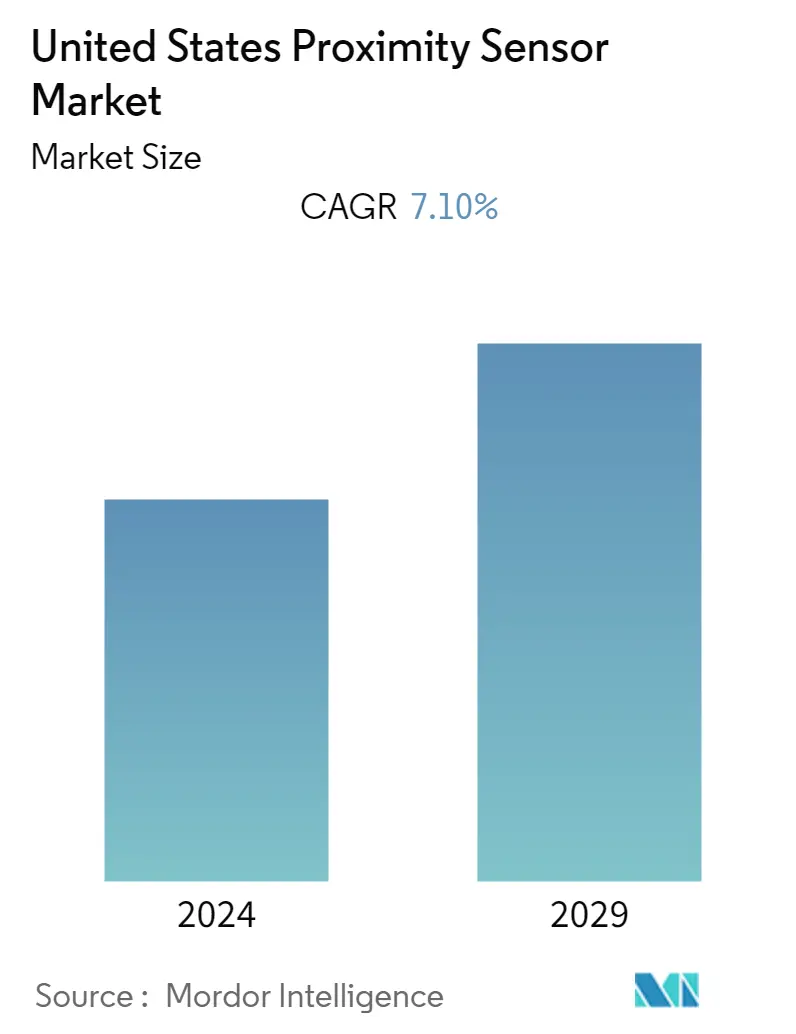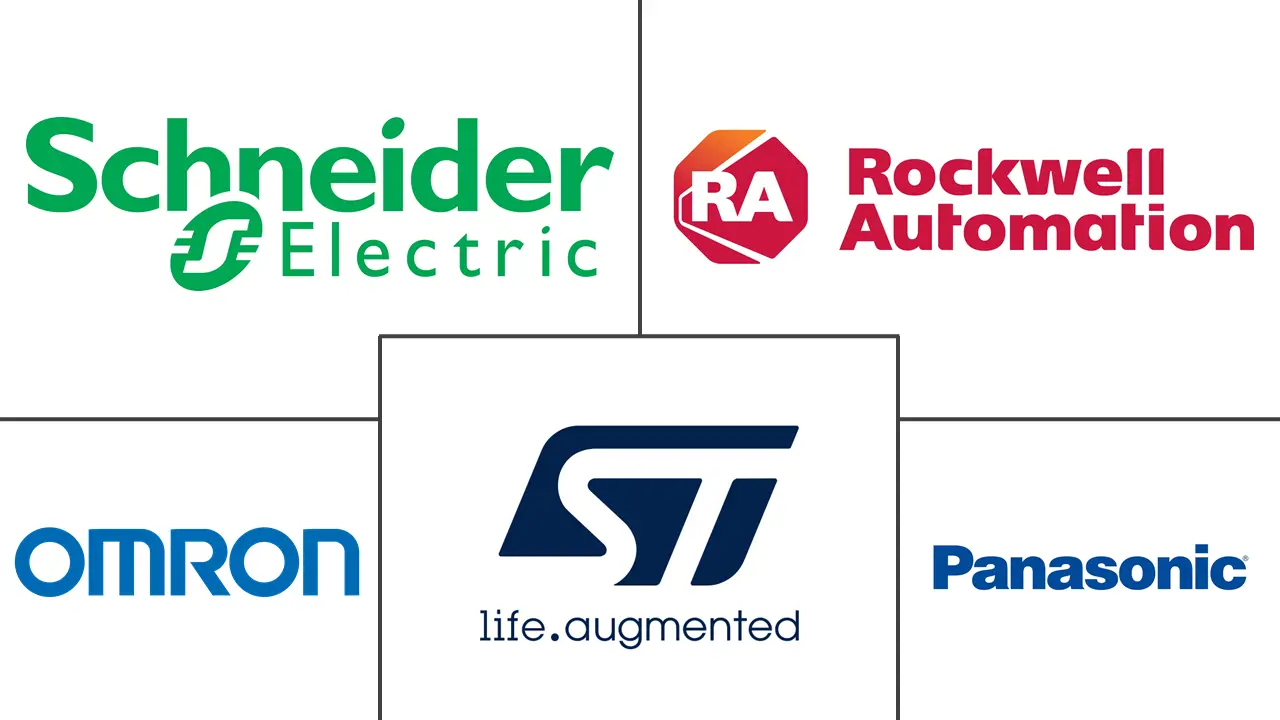Market Size of United States Proximity Sensor Industry

| Study Period | 2019 - 2029 |
| Base Year For Estimation | 2023 |
| Forecast Data Period | 2024 - 2029 |
| Historical Data Period | 2019 - 2022 |
| CAGR | 7.10 % |
| Market Concentration | Low |
Major Players
*Disclaimer: Major Players sorted in no particular order |
US Proximity Sensor Market Analysis
The United States Proximity Sensor Market is expected to grow at a CAGR of 7.1% over the forecast period (2021 - 2026). All sensors that detect objects without physically contacting them are referred to as proximity sensors. Proximity sensors convert information about an object's movement or presence into an electrical signal. These sensors are frequently used in parking lots, mobile phones, conveyor systems, and other industrial settings. The Industrial Internet of Things, which calls for sensor-based measurements for decision support, analysis, and purposes, is one of the market drivers.
- In the United States, modern facilities are becoming more complex and diverse with urbanization and population growth. For instance, according to a world development indicators survey conducted by the World Bank, it was found that the degree of urbanization in the United States was 82.66% in 2020.
- The sensor information data would aid in managing various urban facilities and the effective response to emergencies and accidents through information sharing. Intelligent urban vehicles would require multiple sensors to monitor a variety of phenomena. These various types of proximity sensors constantly monitor the position and control of the vehicle, increasing their demand in urban infrastructures and propelling the proximity sensor market forward.
- Moreover, in the era of technological advancement, new innovative proximity sensors - Time of Flight (ToF) sensors - can protect health in various ways while maintaining social distance. For instance, STMicroelectronics introduced high-performance proximity and ranging sensors based on FlightSense Time of Flight technology in July 2020. These Time of Flight (ToF) sensors aid in developing 3D sensing capabilities for a wide range of products used by customers daily.
- Further, with the growing impact of COVID-19 on various industries, businesses are following social distance through advanced technologies. As a result of the pandemic, the demand for proximity sensors has increased as they improve workplace safety and ensure contact tracing through proximity detection tags to ensure business continuity.
- However, designing miniaturized sensors without affecting their quality poses a challenge for the proximity sensor market growth.
US Proximity Sensor Industry Segmentation
A proximity sensor is a sensor that detects the presence of nearby objects without the need for physical contact. A proximity sensor frequently emits an electromagnetic field or a beam of electromagnetic radiation (for example, infrared) and detects changes in the field or return signal.
The United States Proximity Sensor Market is Segmented by Technology (Inductive, Capacitive, Photoelectric, Magnetic, Ultrasonic), Channel Type (Single Channel and Multi-Channel), End-User (Aerospace and Defense, Automotive, Automation, Industrial, Consumer Electronics, Food & Beverage, Pharmaceutical, Construction, Energy).
| Technology | |
| Inductive | |
| Capacitive | |
| Photoelectric | |
| Magnetic | |
| Ultrasonic | |
| Other Technology |
| Channel Type | |
| Single Channel | |
| Multi-Channel |
| End-User | |
| Aerospace and Defense | |
| Automotive | |
| Industrial Automation | |
| Consumer Electronics | |
| Food & Beverage | |
| Pharmaceutical | |
| Construction | |
| Energy | |
| Other End-users |
United States Proximity Sensor Market Size Summary
The United States Proximity Sensor Market is experiencing significant growth, driven by the increasing complexity of modern facilities due to urbanization and technological advancements. Proximity sensors, which detect objects without physical contact, are integral in various applications such as parking systems, mobile devices, and industrial automation. The rise of the Industrial Internet of Things (IIoT) is a key factor propelling market expansion, as these sensors provide essential data for decision-making and analysis. In urban environments, the demand for proximity sensors is further amplified by the need for intelligent urban vehicles and infrastructure, which require constant monitoring and control. The introduction of innovative sensors like Time of Flight (ToF) technology enhances capabilities such as 3D sensing, contributing to market growth. Additionally, the COVID-19 pandemic has accelerated the adoption of proximity sensors to ensure workplace safety and facilitate social distancing measures.
In the automotive sector, proximity sensors play a crucial role in enhancing vehicle safety and supporting autonomous technologies. These sensors are vital for advanced driver-assistance systems (ADAS), which are becoming increasingly important due to regulatory and consumer safety demands. The market for automotive proximity sensors is bolstered by the growing interest in connected and autonomous vehicles, driven by rising consumer income and demand for luxury features. Inductive proximity sensors, known for their reliability in harsh environments, are widely used in industrial automation, agriculture, and material handling. Despite their limitations in detecting non-metal objects, these sensors are essential for improving productivity and safety in various industries. The market is characterized by intense competition among key players like STMicroelectronics, OMRON Corporation, and Honeywell International Inc., who are actively pursuing strategic collaborations to enhance their market presence and technological capabilities.
United States Proximity Sensor Market Size - Table of Contents
-
1. MARKET DYNAMICS
-
1.1 Market Overview
-
1.2 Industry Attractiveness - Porter's Five Forces Analysis
-
1.2.1 Threat of New Entrants
-
1.2.2 Bargaining Power of Buyers
-
1.2.3 Bargaining Power of Suppliers
-
1.2.4 Threat of Substitute Products
-
1.2.5 Intensity of Competitive Rivalry
-
-
1.3 Industry Value Chain Analysis
-
1.4 Assessment of the Impact of COVID-19 on the Market
-
-
2. MARKET SEGMENTATION
-
2.1 Technology
-
2.1.1 Inductive
-
2.1.2 Capacitive
-
2.1.3 Photoelectric
-
2.1.4 Magnetic
-
2.1.5 Ultrasonic
-
2.1.6 Other Technology
-
-
2.2 Channel Type
-
2.2.1 Single Channel
-
2.2.2 Multi-Channel
-
-
2.3 End-User
-
2.3.1 Aerospace and Defense
-
2.3.2 Automotive
-
2.3.3 Industrial Automation
-
2.3.4 Consumer Electronics
-
2.3.5 Food & Beverage
-
2.3.6 Pharmaceutical
-
2.3.7 Construction
-
2.3.8 Energy
-
2.3.9 Other End-users
-
-
United States Proximity Sensor Market Size FAQs
What is the current United States Proximity Sensor Market size?
The United States Proximity Sensor Market is projected to register a CAGR of 7.10% during the forecast period (2024-2029)
Who are the key players in United States Proximity Sensor Market?
STMicroelectronics, OMRON Corporation, Rockwell Automation, Inc., Schneider Electric and Panasonic Corporation are the major companies operating in the United States Proximity Sensor Market.

